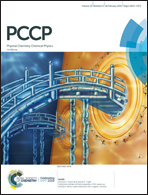The structural determination and skeletal ring modes of tetrahydropyran†
Abstract
A high-resolution molecular spectroscopy study was carried out on the cyclic ether tetrahydropyran (THP), one of the smallest molecules composed of a pyranose ring. As this ring structure is closely related to carbohydrates, THP can offer relevant insight into structural variations of this unit. Thus, an extensive probe of THP using three broadband instruments ranging from the microwave to the far-infrared (2–8 GHz, 75–110 GHz and 100–650 cm−1 frequency ranges) was performed to accrue both accurate sets of rotational constants and structural information. This array of experimental setups provided an accurate set of data to improve the description of the ground state of THP and revise the principal parameters of its backbone structure. The structural information was deduced from the assignment of the 13C and 18O isotopologues present in natural abundance. In addition, the complementary dataset obtained from these experiments led to a better characterization of the vibrational motions involving the skeletal ring of the molecule. In particular, the vibrational frequencies of four of these modes (ν23 (∼250 cm−1), ν22 (∼403 cm−1), ν21 (∼430 cm−1), and ν20 (∼562 cm−1)) have been determined from the analysis of the first rotationally resolved vibrational spectrum reported for THP. Quantum-chemical calculations aided in the analysis of the experimental results.



 Please wait while we load your content...
Please wait while we load your content...